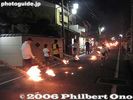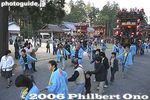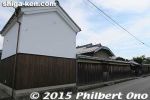 Image search results - "hino-cho" Image search results - "hino-cho" |

Very little remains of Otowa castle originally built by Lord Gamou Sadahide. Two battles took place here in 1496 and 1503. Road to Otowa Castle on the hill seen on the left.
|
|

Hino was home to many Omi merchants who plied up and down Japan during the Edo Period to sell and trade their wares. They became quite successful selling medicines, lacquerware, sake, etc. Those from Hino were called Hino shonin (Hino merchants).
|
|

Hino's most prominent shrine is best known for the Hino Matsuri festival on May 2-3. The shrine was originally atop Mt. Watamuki, Hino's tallest mountain. It was moved to its present location in 796.
|
|

Nakano Castle, also known as Hino Castle, built in 1534 by Lord Gamou Sadahide (1508-1579). In 1582, when Oda Nobunaga was assassinated in Kyoto, Lord Gamo Katahide brought Nobunaga's wife and children from Azuchi Castle to Hino Castle for their safe
|
|

Held for two evenings on Aug. 14-15 during the obon season, people light their torches at Gosha Shrine and proceed to Hibarino park where the torches are thrown up to a large pine tree. The more torches get stuck on the tree, the better the next harvest.This is Hibarino park. The pine tree on the right of the small hill is the target for the torches. This park also serves as the Otabisho during the Hino Festival.
|
|

Barrels of Hino merchant sake
|
|

The castle is somewhat out of the way. It's a 15-min. walk from the nearest bus stop.
|
|

Later the shrine became Lord Gamou's family shrine and it was revered by Hino merchants during the Edo Period. This is the Shrine grounds. Map
|
|

The castle was abandoned in 1597. Only a few stone walls and shrines remain adjacent to Hinokawa Dam. This is one entrance to Nakano Castle. Map
|
|

Entrance to Gosha Shrine. 五社神社
|
|

The shrine also holds the Hino Matsuri on May 2-3.
|
|

The castle met its demise in 1522 less than 60 years after it was built, after a war within the Gamou Clan. It now serves as a large hilltop park with good views of the surroundings. Otowa Castle marker
|
|

Manhole with the symbol of Hino merchant, Shiga Prefecture
|
|

Torii at Umamioka Watamuki Shrine in Hino, Shiga Pref.
|
|

Path to Nakano Castle ruins
|
|

Gosha Shrine torii
|
|

Suzuka Quasi-National Park markerThe area is within this park.
|
|

Omi Hino Merchant House. The former home of Hino merchant Yamanaka Hyouemon was donated to the town in 1981. Now a museum exhibiting the history and artifacts of the Hino merchants. 近江日野商人館Small admission charged. Open 9 am to 4 pm, closed on Mon. and Fri. Close to the center of town.
Address: Okubo 1011, Hino-cho
Phone No.: 0748-52-0007
山中兵右衛門
|
|

Stone bridge
|
|
|
|
|

Entrance to castle grounds, now a picnic and playground.
|
|
|

Stone bridge
|
|

Nakano (Hino Castle) in Hino, Shiga Pref. The castle was built in 1534 by Lord Gamou Sadahide (1508-1579).
|
|
|

Castle monument
|
|

Inside Omi Hino Merchant House近江日野商人館
|
|
|
|
|

Pile of straw to be lit. The fire is used to light all the torches.
|
|

Hilltop left
|
|

Lacquerware sold by Hino merchants近江日野商人館
|
|

Mikoshi portable shrine
|
|

In 1582, when Oda Nobunaga was assassinated in Kyoto, Lord Gamo Katahide brought Nobunaga's wife and children from Azuchi Castle to Hino Castle for their safety. The castle was abandoned in 1597.
|
|

White and red torii
|
|

Otowa Castle's hilltop center, now a playground.In Hino, Shiga Pref.
|
|

Inside Omi Hino Merchant House
|
|

Rear view
|
|
|

Torches
|
|

Hilltop right
|
|

Inside Omi Hino Merchant House
|
|
|
|
|

After it gets dark, the pile of straw is lit and people come to light their torches.
|
|
|

Inside Omi Hino Merchant House
|
|
|
|

Torii and steps to Inari Shrine
|
|

Lighting torches.
|
|

Trench or moat
|
|

Inside Omi Hino Merchant House
|
|
|
|

The torch procession goes from Gosha Shrine to Hibarino park.
|
|

Well used by the castle
|
|
|
|

Steps to Inari Shrine
|
|
|
|
|

Clothing worn by Hino merchants
|
|

Garden
|
|

Inari Shrine torii
|
|

During the procession, children use sticks to hit the torch flame. They had great fun.
|
|

Nice view of adjacent reservoir 日渓溜
|
|

Travel passport required to travel around Japan
|
|

Senryo Matsu pine tree千両松
|
|
|
|

Flowers in bloom in early May
|
|

Sake containers
|
|

Painted (and fading) wooden tablets
|
|

Inari Shrine 稲荷神社
|
|
|

Adjacent reservoir
|
|

Medicine
|
|

Painted (and fading) wooden tablet
|
|
|

Hino Hifuri Festival, Shiga.
|
|

Hinokawa River 日野川
|
|
|
|

Hibarino park. Map
|
|

Rice paddies near the castle
|
|

Shakunage or rhododendron
|
|

Ryokyo Shrine 凉橋神社
|
|
|
|

Toward the exit
|
|

Well used by Lord Gamou
|
|

This man holds multiple torches.
|
|

Hinokawa Dam Park 日野川ダム公園The dam is right behind the castle ruins. These pictures were taken in early May when flowers were in bloom.
|
|

Throwing a torch up the pine tree. Very few people succeeded in landing the torch on the tree (which doesn't burn down).
|
|

Hinokawa Dam Park and Mt. Watamuki. 日野川ダム公園綿向山
|
|

Hinokawa Dam Park 日野川ダム公園
|
|

Hinokawa Dam Park 日野川ダム公園
|
|

Local souvenir shop uses a former Omi shonin home in Hino.
|
|

A room inside a renovated Hino merchant home.
|
|

Some laquerware sold in a renovated Hino merchant home converted into a store.
|
|

Minami Sanno Matsuri Festival is held annually on April 4 by Hieda Jinja Shrine in Okubo and Seon (大窪、清雲). 南山王の祭 Map
|
|

Minami Sanno Matsuri Festival is like a picnic under streamers called hoinobori.
|
|

The hoinobori are carried from the respective parishioners neighborhoods to this park next to the shrine.
|
|

Minami Sanno Matsuri Festival. For a few hours, they gather under the hoinobori with food and drinks.
|
|

View from Hieda Shrine.
|
|
|

Minami Sanno Matsuri Festival in Hino, Shiga.
|
|

Under a hoinobori, made of bamboo strips wrapped with paper and attached with paper flowers, usually pink.
|
|

Hoinobori paper flower.
|
|

Hieda Shrine
|
|

Hieda Shrine
|
|

Hieda Shrine 日枝神社
|
|

Inside Hieda Shrine 日枝神社
|
|

Wedded trees at Hieda Shrine
|
|

Shakunage or rhododendron
|
|

Statue of Lord Gamou 蒲生氏郷公像
|
|

Statue of Lord Gamou 蒲生氏郷公像
|
|

Sign opposing the proposal to build an airport in 2006. The airport plan has since been abandoned.
|
|

Hibarino park ひばり野
|
|

Shingyo-in Temple belongs to the Jodo-shu Buddhist Sect. It was the Gamou clan's family temple. 信楽院
|
|

Shingyo-in Temple 信楽院
|
|

Mini wisteria
|
|

Bus stop
|
|

Unkoji Temple, famous for satsuki azaleas. 雲迎寺(さつき寺)Very many azalea bushes.
|
|

Unkoji Temple, famous for satsuki azaleas. 雲迎寺(さつき寺)
|
|

Tea bushes grown organically
|
|

Held annually during May 2 and 3, the Hino Matsuri is the largest festival in eastern Shiga Pref. In 2006, sixteen ornate floats and three portable shrines were paraded through the streets. It is the spring festival of the Umamioka Watamuki Shrine.
|
|

Nishinomiya Shrine on May 2, 2006 西之宮
|
|

Portable shrine (mikoshi) at Nishinomiya Shrine. The mikoshi are carried to this nearby shrine from Watamuki Shrine. 西之宮
|
|

Ceremony at Nishinomiya Shrine西之宮
|
|

Warehouse for one of the floats
|
|

May 2: Night Festival where the floats are lit up at night 宵祭
|
|

Pulling a float on the festival eve starting at 7 pm.
|
|

May 2: Night Festival 宵祭
|
|

May 3, 2006: Hino Matsuri at Umamioka Watamuki Shrine 本祭(馬見岡綿向神社)Map
|
|

The 16 floats start entering the shrine grounds during 9:30 - 11:00 am.
|
|

Another dashi float is hauled to the shrine. 南大窪町の「南壮社(なんそうしゃ)」
|
|

Pulling another float at the Hino Matsuri, Shiga Pref.
|
|
|

"Yoisho!" (Heave ho!)
|
|

Steering the float
|
|

Steering the float with a stick stuck under the wheel to nudge it in the desired direction.
|
|

One by one, all the floats gather at the shrine.
|
|
|

My video of Hino Matsuri on May 3, 2011.
|
|

Each float has a decoration on the roof depicting a popular topic during the past year. This is Yamauchi Kazutoyo and wife Chiyo from the NHK Taiga Drama called "Komyo ga Tsuji.""Komyo ga Tsuji" is about a up and coming samurai named Yamauchi Kazutoyo and his wife Chiyo who was from Shiga. The story's main setting is Shiga, and the year-long TV series was broadcast during 2006.
|
|

World Cup soccer 南大窪町の「南壮社(なんそうしゃ)」
|
|

Ito Miki, a member of Japan's moguls team at the Turin Winter Olympics, is from Hino.
|
|

Ukiyoe
|
|

Commemorating Tezuka Osamu's 60th anniversary since his debut as a manga artist. That's Tetsuwan no Atom or Astro Boy.
|
|

"Oh Japan" for the World Baseball Classic won by Japan and coached by Oh Sadaharu.
|
|

A bug
|
|

Float named Man'ensha. Built in 1860 (Man’en 1). 萬延社Constructed in 1860 (Man’en 1). For the first 70 years since its construction, the wood used in this hikiyama was unfinished; but to commemorate the enthronement of Emperor Showa, in 1929 (Showa 4) a black lacquer finish as well as gold leaf and decorative metalwork was added.
|
|

Back of a float
|
|

Rear view of floats
|
|

Side view of a float
|
|

Closeup of the steps
|
|

Float named "Kanbusha" 観舞車
|
|

Float named "Hakkei-kaku" featuring small sculptures of the Eight Views of Omi. Built in 1807. Metal ornamentation as well as painted wood carvings on the front and upper transom depicting the Eight Famous Views of Ōmi... 八景閣Constructed circa 1807 (Bunka 4), from Shin-cho. Metal ornamentation as well as painted wood carvings on the front and upper transom depicting the Eight Famous Views of Ōmi create an elaborate adornment to the entryway of this splendid hikiyama.
|
|

Miss Shakunage (Rhododendron) pose in front of a float. There is a valley nearby famous for rhododendron.
|
|

Miss Shakunage (Rhododendron)
|
|

One float (from Shimizu-cho) provided an explanation about the float in English.
|
|

Float from Shimizu-cho with a panel explaining about the float in both English and Japanese. Carved panels depicting the Twenty-four Paragons of Filial Piety by famed Suwa woodcarver, Tatekawa Washirō and a wave design drawn by Kyōto artist Mankō are..Constructed in 1825 (Bunsei 8). Carved panels depicting the Twenty-four Paragons of Filial Piety by famed Suwa woodcarver, Tatekawa Washirō and a wave design drawn by Kyōto artist Mankō are of great beauty. The gold leaf and lacquer adorning this hikiyama was applied by a Shimizu-chō resident artisan employing the utmost skill and devotion.
|
|

TV personality Daniel Kahl and a fan at Hino Matsuri, Hino, Shiga Prefecture. ダニエル・カールWhat's this guy from Yamagata-ken doing here at the Hino Matsuri in Shiga Pref??
ダニエル・カール
|
|

The floats were very colorful against the greenery.
|
|

It was the finest day for the Hino Matsuri festival.
|
|

The three "Kamiko." 神子
|
|

Ceremony at the shrine
|
|

Kamiko. 神子 芝田楽 (shibadengaku)
|
|

After the ceremony, the Kamiko lead the procession.
|
|

Kamiko神子
|
|

The procession head for the Otabisho at 11:30 am. 渡御出発
|
|
|
|

Horse
|
|

The first mikoshi approaches.
|
|
|
|
|
|
|
|

Some chidren lead the way for the second mikoshi.
|
|

The second mikoshi makes its way through.
|
|
|
|
|
|

They exit shrine and head for the Otabisho.
|
|
|

Shrine priest in the procession heading for the Otabisho.
|
|

Break
|
|

Mikoshi
|
|

Refreshments served. On the left is the unique sajiki-mado window for viewing the festival.
|
|

Special viewing window called "sajiki-mado" at Hino Matsuri. They view the Hino Festival procession from this special window. 桟敷窓
|
|

The procession proceeds with people chanting "yare, yare."
|
|
|
|
|

One of the three mikoshi on its way to the Otabisho.
|
|
|
|

Entrance to Hibarino Otabisho ひばり野 お旅所
|
|

The procession reaches the Otabisho at 12:30 pm.
|
|

Kamiko receive many gifts.神子
|
|

Two of the mikoshi already at the Otabisho.
|
|

Phoenix atop a mikoshi
|
|

Mikoshi closeup
|
|

Mikoshi closeup
|
|

Mikoshi closeup
|
|
|
|
|
|

The third mikoshi arrives.
|
|
|

The three mikoshi.
|
|

The three mikoshi at the Otabisho.
|
|
|

Ceremony at Otabisho お旅所祭典
|
|

Ceremony at Otabisho
|
|
|

Sacred dance is performed.
|
|

Procession ready to leave the Otabisho at 3 pm.
|
|
|
|
|
|

The three mikoshi start to leave the Otabisho.
|
|
|
|
|

The second mikoshi leaves.
|
|

The mikoshi on its way back to Watamuki Shrine.
|
|

One of the mikoshi arrives back at Watamuki Shrine at around 4 pm.
|
|

A mikoshi on its way to the shrine.
|
|
|
|
|
|
|

Mikoshi at the shrine
|
|

Body toss
|
|

The three Kamiko.神子
|
|

At 6:00 pm, the procession starts to leave the shrine.
|
|
|

The floats also start to leave the shrine.
|
|
|
|
|

The floats leave the shrine one after another.
|
|

Float named "Jusosha" leave the shrine. 寿雙車
|
|

Enjoying a free ride home.
|
|
|
|

Storehouse for float
|
|

A sign in front of the storehouse introduces the float in Japanese, English, and Korean.
|
|

Another Hino merchant home to visit is the Omi Hino Shonin Furusato-kan (近江日野商人ふるさと館). Former grand residence of Hino merchant Yamanaka Shokichi (旧山中正吉邸).
|
|

Entrance to the Omi Hino Shonin Furusato-kan (近江日野商人ふるさと館). On the road leading to the entrance of Umamioka Watamuki Shrine.Yamanaka Shokichi was a Hino merchant born in 1809. He became a sake brewer in Shizuoka Prefecture. By the 1920s, his family became one of Shizuoka's most successful sake brewers.
|
|

Omi Hino Shonin Furusato-kan was purchased and restored by Hino Town. It opened in April 2015.
|
|
|
|